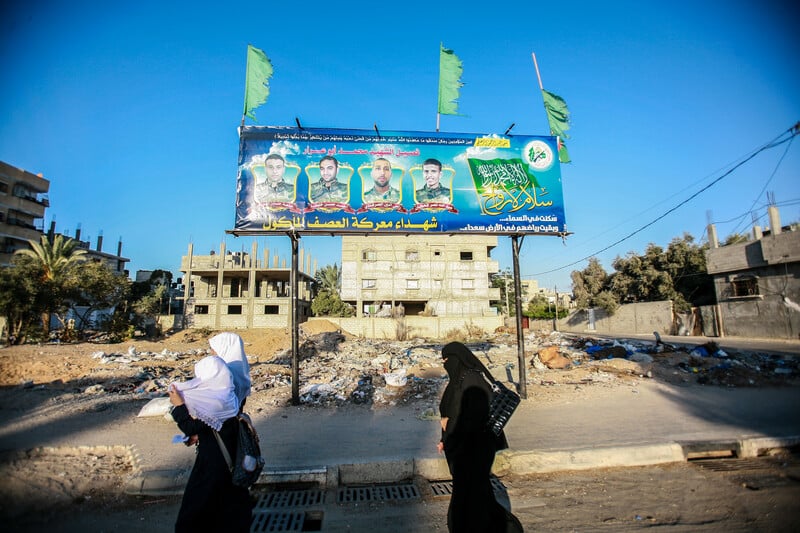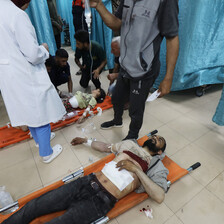The Electronic Intifada Gaza Strip 8 November 2016

A billboard marks the location where Juma al-Hams (first from left) and two other fighters were killed. A fourth fighter shown in the poster was killed in a separate incident.
On 31 July, workers clearing rubble from a house destroyed in a 2014 Israeli bombing in the Shujaiya neighborhood of Gaza City discovered part of a human skeleton.
Police were summoned and the remains were taken away for examination.
But identification proved impossible, Ayman al-Batniji, a Gaza police spokesperson, later told The Electronic Intifada. The remains, he said, have since been buried and were likely two years old.
“We were not able to ID the skeleton, but we expect that it belongs to one of the martyrs of the last war since it was discovered during a clean-up of one of the houses shelled then.”
The find was a grim reminder that two years after Israel’s 2014 onslaught on the Gaza Strip people are still missing, most presumed dead.
Gaza’s ministry of health acknowledges that the exact number is not known. The ministry is still trying to follow up with local human rights groups and the International Committee of the Red Cross (ICRC), according to ministry spokesperson Ashraf al-Qedra.
The ICRC, which handles issues related to Palestinian prisoners or those whose bodies have been interred by Israel, is following six cases of missing persons, according to spokesperson Suhair Zakkout.
But the cases at the ICRC are only those where families have come forward. Some have not reported their missing relatives to the ICRC simply because there is no suggestion that they were seized. Others, where relatives may have been active in the Palestinian resistance, do not want to offer Israel any information.
The grief in a father’s heart
Every day after dawn prayers, Hussein al-Hams, 66, goes in search of his son Juma in the rubble of a building east of Rafah, Gaza’s southernmost city. Juma went missing on 1 August 2014 when he was 22. The day became known as Black Friday.
Black Friday was actually one of four days. It was a particularly brutal episode in a devastating 51-day Israeli onslaught on Gaza that saw more than 2,200 Palestinians killed.
The overwhelming assault came after Hamas fighters captured an Israeli soldier and the Israeli military triggered its Hannibal Directive in response – authorizing it to use massive and indiscriminate firepower across the entire area where the soldier might be to prevent his capture alive.
According to Amnesty International, between 135 and more than 200 civilians died in the bombardment before it eased off on 4 August with a ceasefire. Many more were wounded and hundreds of homes and buildings were destroyed.
Among them was a multi-story building belonging to the al-Sarafandi family. Inside were Juma, Rami al-Sarafandi and Ahmad Khalifa, according to the Rafah office of the Qassam Brigades, Hamas’ military wing, which claimed the three as members, and announced that all had died.
But only two bodies were found, those of al-Sarafandi and Khalifa. Juma’s father clings to the hope that somehow his son escaped the fate of the other two. He keeps returning to the al-Sarafandi building to rummage through the rubble with his bare hands.
“Since there’s no body or trace of my son, I’ll continue doing the same until I hear of Juma or find his body,” al-Hams told The Electronic Intifada.
Husam, 36, Juma’s older brother, does not share his father’s hope.
“I’m sure that my brother was killed. It’s not possible that he’s still alive or was arrested by Israel,” he said, citing the Qassam announcement as well as his understanding that a three-day search was made for the bodies.
“We hope to find something to soothe the grief in our father’s heart.”
Mahmoud Fawda, a local reporter with Alresala newspaper, was in the area at the time of bombardment. He said it was unlikely anyone escaped the bombing.
“The shelling was like a volcano,” he told The Electronic Intifada. “It destroyed the houses and left the area unrecognizable.”
Also convinced of Juma’s demise is his mother, Suhair, 62.
“A mother’s feeling never lies. I know he’s dead, but I still hope to find his body or even a part of it; to have a tomb for him so that I can visit him, to lay some roses, and read the Quran for him.”
Husam is thinking about building a symbolic tomb in his brother’s memory for his mother. But his father refuses the idea. Be patient, he tells Husam.
The disappearance of Nour
Just a little north of Rafah, the family of Nour Omran in Khan Younis is still clinging to the hope that the teenager, 16 when he disappeared, is still alive.
The family is in contact with human rights organizations, members told The Electronic Intifada, to ascertain whether he was captured by Israel or killed.
Nour’s case, one of the six with the ICRC, is one of the most puzzling. He went missing on 23 July 2014 in al-Qarara village east of Khan Younis, which was severely hit during the Israeli offensive.
Nour’s mother Rihab, 45, was the last to see him before his disappearance. He had gone to the family’s poultry farm in the area, according to Rihab, and only after he left did the family hear that Israeli troops had invaded the area.
When family and friends later gained access to the farm, which had been destroyed in the bombardment, they only found Nour’s motorcycle and keys, Rihab told The Electronic Intifada. There were no traces of blood or other signs of violence.
“For me, the war never ended,” Rihab said. “I don’t know until this moment whether my son is alive or dead. Was he arrested? Dead? His body, is it among the rubble or with the Israelis? I still don’t know.”
The family provided DNA samples to the ICRC to give to Israeli authorities to ascertain whether he is held captive – dead or alive. But according to the ICRC’s Zakkout, while there was initial cooperation, once the samples were submitted at the beginning of 2015 there has been no response from the Israeli side.
“Israel responded at the beginning, but after the DNA samples were delivered, cooperation stopped,” Zakkout said, adding that the ICRC is still pursuing the case with Israel.
Deliberate obfuscation
Mervat An Nahhal, director of the legal aid unit at Al-Mezan Center for Human Rights, said Israel had been generally unresponsive to requests for information about the six cases filed by rights organizations.
But while the six cases reported remain unresolved, this is not the end of the story, according to An Nahhal. “This number, six missing, doesn’t cover all the missing. In many cases, there is zero information available, and we were not able to reach their families or get their authorization to start an investigation.”
Omran’s family will continue living in limbo until they learn what became of Nour.
“It’s far easier to know that he is dead than to continue this grief, ignorant of his fate,” his mother said.
In March 2015, HaMoked, an Israeli human rights group, reported that the Israeli army held the bodies of 19 Palestinians slain during the 2014 offensive. According to the military’s response to a freedom of information request in 2014, conclusive identification of the bodies had not been carried out, nor would the military reveal where the bodies are buried.
These remains mostly belong to Qassam fighters. At least 10 are from a single infiltration across the Gaza boundary on 21 July 2014 – an attack on a military position near Nir Am, east of Beit Hanoun in Gaza and west of Sderot, an Israeli town near northern Gaza.
In total, of the 19 bodies Israel admits to holding, 14 are of Qassam fighters. Five are unknown.
The Ramallah-based human rights group Al-Haq stated in November last year that “By retaining the bodies of those killed, Israel is directly violating its obligations under international law.” The group urged “Israel to return the bodies of the deceased to their families for proper burial and mourning.”
Riad al-Ashqar, a spokesperson for the Palestinian Prisoners Center for Studies, told The Electronic Intifada that Israel has two considerations when dealing with the issue of missing bodies. First, there is a security dimension. Israel keeps information obscured for the purpose of aiding negotiations over any exchange of bodies or prisoners.
Second, al-Ashqar added, Israel is “deliberately augmenting the suffering of the Palestinian people in general and the families of those missing in particular” to act as a form of deterrence.
Losing hope
Fayez Abu Shamalah, a lecturer at Al-Aqsa University and a political analyst who himself spent 20 years imprisoned in Israel, said the Israeli military is extremely cautious on this issue with the intention of disclosing as little information as possible in order to improve its bargaining position ahead of any exchange negotiations with Hamas over prisoners and bodies.
In September, Lior Lotan, Israel’s chief negotiator, said talks over the return of the 19 bodies had broken down, accusing Hamas of demanding the release of prisoners not from Gaza.
In al-Tuffah, east of Gaza City, Majid al-Batsh has stopped looking for his missing relatives. The 55-year-old lost 18 members of his family in two strikes on family houses on 13 July 2014.
Of those, only 13 are accounted for. The bodies of five people, including a pregnant woman and two children, as well as Majid’s son Jalal, 26 at the time, have never been found, he said.
Majid has stopped looking for his son. He says he believes Jalal was burned to ashes. Two months ago, he asked the civil defense – which had been sifting through the rubble to identify human remains – to stop looking as well.
Hamza Abu Eltarabesh is a freelance journalist and writer from Gaza.




